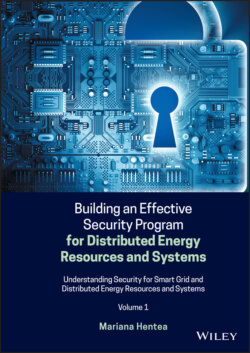Читать книгу Building an Effective Security Program for Distributed Energy Resources and Systems - Mariana Hentea - Страница 10
Оглавление
Foreword
“Just because something doesn’t do what you planned it to do doesn’t mean it’s useless.” (Thomas A. Edison, US Inventor)
Environmental policies, energy rising costs, and technology innovations are challenging many assumptions that were used to build current electric utility infrastructure, which has been evolving for more than a century. The power grid is the most complex man‐made system that allows access to electricity, a fundamental enabler for the economy. While access to electricity is the greatest engineering achievement of the twentieth century, the grid of today does not have the attributes necessary to meet the demands of the twenty‐first century and beyond.
The Smart Grid paradigm promises to improve the power grid reliability and enable sustainability and customer choice. To meet the power grid concerns, utilities around the world are investing in distributed energy resources (DERs). However, different utilities have different reasons and business drivers for investing in DERs management. Besides grid reliability, the increasingly rapid adoption of DERs is driven by other factors such as to meet the world's energy efficiency and greenhouse gas emission goals. With these drivers for investing in DERs and Smart Grids, cybersecurity solutions are imperative for reliable energy delivery. In highly connected world via Internet and with an increasing sophistication of threats, it is unrealistic to assume energy delivery systems are isolated or immune from compromise.
To achieve the interoperability of Smart Grid devices and systems, it is required that standards and protocols align policy, business, and technology in a manner that would enable all electric resources, including demand‐side resources, to contribute to an efficient, reliable electricity network. There is a need to understand that ensuring cybersecurity and privacy of the information is more than conformance to standards.
Security and privacy needs for Smart Grid and DERs, strategies, security requirements, risk management, security and privacy design, and countermeasures as well as standards and best industry practice recommendations are discussed in this book.
Understanding Security for Smart Grid and Distributed Energy Resources and Systems (Vol 1)
Building Security Program for Smart Grid and Distributed Energy Resources and Systems (Vol 2)
Effective Security Program for Smart Grid and Distributed Energy Resources and Systems:
An Engineering Approach (Vol 3)
The aim of this three-volume book is building security and privacy programs to support the development of Smart Grid Systems and DER systems that are reliable, secure, resilient, and flexible. The cybersecurity problem becomes a very complex problem for the Smart Grid system, defined also a system of systems. The basic concepts, approaches, and frameworks are described in this three-book set. Smart Grid and DERs security and privacy issues are gradually introduced and discussed from many perspectives.
The sequence is starting with introductory topics for the security and privacy programs and Smart Grid and DER needs (Volume 1), followed by more advanced and detailed functions of the programs as well as discussion of Smart Grid and DER characteristics, vulnerabilities, threats, potential risks (Volume 2), to efficient and effective security and programs that include monitoring, reporting, and control based on security measurements and security metrics as well as intelligent decision-making (Volume 3). Each volume and some topics can be used independently for limited purposes.
These books include information about strategies, security requirements, risk management, security design, and countermeasures as well as regulations, standards, and best practice recommendations. The focus is on describing the most specific issues of Smart Grid and DERs including building security and privacy program blocks to handle several aspects of the security and privacy risks for the Smart Grid and DER systems. These books demonstrate how to blend Engineering techniques with standards and best security practices. Finally, a perspective on the future DER systems cannot be discussed without taking a look at the vision on the future Smart Grids and research needs.
The information provided in this three-volume book could be used to educate current workforce, future graduates, academic/research, and regulators to understand the complex cybersecurity domain in the context of the various paradigms (e.g. Smart Grid, convergence of security by design and privacy by design) and emerging technologies (e.g. Internet of Things, wireless technologies, big data analytics, machine learning, intelligent control, and decision-making).
